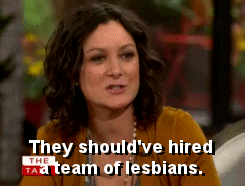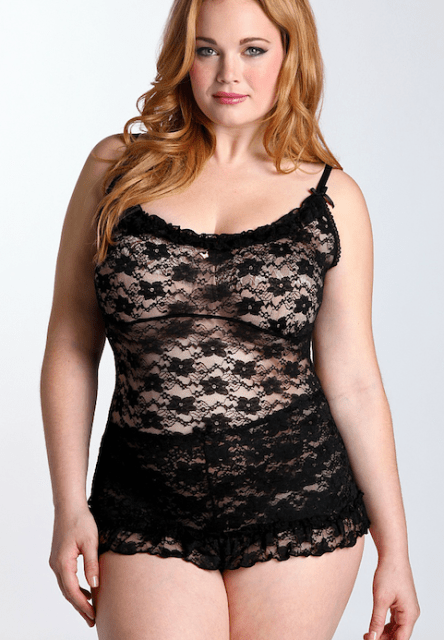Welcome to NSFW Lesbosexy Sunday!

via suicide girls
+ There is a new piece of lesbian erotica on Sugarbutch, featuring spanking, strap-on sex, and a striptease, that you should read immediately:
“She blushes a little, looks down with a half-smile. She can tell I’m watching her. Her hands flutter the menu closed and she releases them to her lap. I slide my hand over to her thigh. She jumps.
‘Relax,’ I say, close to her ear. ‘No one can see.’
‘How do you know,’ she shoots back quietly.
‘The tablecloth,’ I finger the satin fabric of her skirt, not quite feeling her stockings through the crinoline. My shoulders are starting to ache, ready to take her, and I shift toward her again. I reach for the hem of her dress and can just barely work my hand under it without making it look like I’m obviously reaching. Her stockings are smooth. Her legs are crossed. She uncrosses them, stockings rubbing together briefly, and parts her knees just a little. I can feel her breath on my cheek and her eyelids are getting heavy. I finger the edge of her simple white panties, then move my fingers under the elastic edge and she’s wet. I can feel it.”

via model mayhem
+ ONCE AGAIN, a scientist is trying to tell us that the G-Spot isn’t real. I’m not sure who keeps investing in these studies but REALLY GUYS, REALLY?





A Yale scientist has suggested that the G-spot isn’t real. In a January 12 issue of the Journal of Sexual Medicine, urologist Amichai Kilchevsky published a study that examined the results of a search across published works for words including G-spot, Grafenberg spot, female orgasm, and female erogenous zone. Her conclusions were not promising:
“‘Objective measures have failed to provide strong and consistent evidence for the existence of an anatomical site that could be related to the famed G-spot,’ Kilchevsky wrote.
Such objective measures, the study notes, have included everything from ‘digital stimulation’ to MRI scans over the past decade. Kilchevsky notes that ‘modern investigative techniques’ may provide more evidence in the future. The study claims the majority of women believe in the G-spot, which Kilchevsky said is thanks to a myth perpetuated by the porn industry and the public media.”
There you go folks. I don’t know what you’ve experienced or where you’ve been in life, but clearly that scientific study is far more relevant than all that.

via curve appeal
+ According to Collectors Weekly, everything you know about the corset is more or less incorrect. No one walked around with 13-inch waists (except in fetish fiction), corsets didn’t re-shape anyone’s organs or cause cancer, and women wore corsets to be fashionable and feel properly dressed. Valerie Steele, director and curator at The Museum at the Fashion Institute of Technology, says:
“Most people today think corsets were extremely dangerous and caused all kinds of health problems, from cancer to scoliosis. And that’s quite inaccurate. Most of the diseases that have been credited to corsets, in fact, had other causes. Corsets did not cause scoliosis, the crushing of the liver, cancer, or tuberculosis. It doesn’t mean that corsets were without any health problems, but it does mean that most modern people are wildly naive in believing the most absurd antiquated medical accusations about corsetry.
For example, the idea of the misshapen liver seems to be a mistake based on the fact that there is a lot of variation in the shape of livers. When doctors did autopsies, they would see these weird-looking livers and they’d go, ‘That was caused by the corset.'”

via Change Lingerie 2011
+ The experiene of asexuality is also a topic in the BBC this week:
“‘[Aromantic asexuals] don’t have any romantic attractions, so in many cases they don’t want to be touched, they don’t want any physical intimacy,’ says [sociologist Mark] Carrigan.
‘[Romantic asexuals] don’t experience sexual attraction, but they do experience romantic attraction. So they will look at someone and they won’t respond sexually to them, but they might want to get closer to them, to find out more about them, to share things with them.'”

by photographer Mike Larremore
+ The US Supreme Court has been asked to rule on nudity on TV. The case relates to a 2003 broadcast of an episode of NYPD Blue, which features the sides of Charlotte Ross’s butt and breasts. In 2011, the case was decided in favour of ABC, but the FCC appealed. According to Slate:
“Waxman patiently explains to the rapt justices that ABC was never sanctioned for over a dozen NYPD Blue episodes over nine seasons that included bare buttocks. Not until the last one. Arbitrary, bad FCC. Then, he raises his arms, Moses-like, to the glorious friezes that surround the interior of the ceremonial courtroom. And then Waxman points to one sculpted classical stone lawgiver after another as he guides the justices through the fleeting bottoms that pervade their lofty spaces: “There’s a bare buttock there, and there’s a bare buttock here,” he marvels. “And there may be more that I hadn’t seen. But frankly, I had never focused on it before.” To which Justice Antonin Scalia grits out, “Me neither,” while all of the justices gape up at the walls above them, like bemused Muppets on Veterinarian Hospital.
That’s right…at the highest court in the land, Seth Waxman dropped the butt-bomb.”

via shelikesher.tumblr.com
+ This week in pubic hair: Now you, too, can get a bikini wax and then pay $225 for a neon-coloured merkin made of fox fur for some reason! Gawker says the result looks like nightmare porno from the mind of Dr. Seuss. I agree.

via fuckyeahlipsticklesbians.tumblr.com
+ The Lingerie Bowl is getting away from girls in lingerie who exist and moving towards girls in lingerie playing a sport:
Disclaimer: All of the photographs on NSFW Sundays are taken from various tumblrs and do not belong to us. All are linked and credited to the best of our abilities in hopes of attracting more traffic to the tumblrs and photographers who have blessed us with this imagery. The inclusion of a photograph here should not be interpreted as an assertion of the model’s gender identity or sexual orientation. If there is a photo included here that belongs to you and you want it removed, please email our tech director at cee [at] autostraddle dot com and it will be removed promptly, no questions asked.



Sometimes I wonder if i’m a Romantic Asexual… =/
Aaaanyways… Love the selection of photos in this post, love them all!
And… of course they will never find the G-Spot… they’re men and scientists that spend most of their time running these studies instead of actually trying to find the G-Spot themselves [personally]… O.o
I’ve decided that when it comes the time to put my scientific knowledge I gain from my college education to good use I will set out on a conquest to prove the G spot exists. Maybe a scientist needs to go out and do some hands on experimentation instead of relying on digital equipment.
Au contrair, digital manipulation may be just what is needed.
Those merkins scare me!
What if this begins a black market for animal fur fetishes, and we have 101 dalmations all over again?!?!
(Except that you’d hope it wouldn’t need 101 puppies…)
My wife wants to know how you attach the merkin, double sided tape?
this is a really good point.
Google suggests perhaps the glue actors use for fake beards.
Spirit gum
All this time I’ve been doing G-spot research on my own time and dime, and I coulda had NIH funding for it?
I’m willing to publish your findings in comparison to my own
Why neon colored merkins, do people really want to look like those troll dolls?
thanks for showing off my story Autostraddle :) NSFW sunday is my favorite. totally dig the photos this week.
For some reason, I initially read “Aromatic asexuals” and thought it was going to be a weirdly-phrased article about pheromones and asexuals.
Me too, or eating or smells or something.
ditto!
Clearly one Amichai Kilchevsky has never felt a G-spot… and I just find that sad.
Unrelated: I am the Lorax and I speak for your crotch decorations!
more like I am the Lorax and I speak for your crotch decorations, for I am a crotch decoration.
Ok..So the first time I stumbled on a Vajazzling without prior knowledge I nearly cracked a tooth and choked on a sparkley pink jewel..A fear under the same circumstances a may think I’m bedding a Muppet!
http://www.youtube.com/watch?v=rcoreV10hI8
Amanda Palmer, Map of Tasmania
Now that would have scarred me for life
Baahahaha the playing cards and the lego made me laugh so hard! This is just an awesome song all around eh!!
I hide my screen in Starbucks too often.
If people want to see hot women playing sports with relatively little on, why don’t they just go to a women’s rugby game? We don’t even wear pads!
First of all, BUTT BOMB!
Second, if anyone needs assistance with G-Spot research, I am more than happy to help with the study
Yes, tight lacing happened, but there’s only so far it can go. If you have a thirty-inch waist, you can’t tighten it down to 16″ — whalebone (and even steel, in 19th century corsets) and cloth just can’t take the strain. As for the experiences of many/most women, we have to remember that corsetry was a wider part of clothing, which varies widely by social class. Upper class women marked their status through clothing in two major ways: the richness of the materials and the design. Upper class women didn’t have to work, and so their clothes showcased that fact. For instance, look at sleeves. Large, poofy, lacy, frilled, or otherwise adorned sleeves are a clear indication that you don’t ever bend over a fire or reach into a washtub. Sleeves could also be cut so tight and formed to the body that it is literally impossible to cross your arms in front of your chest- because you don’t have to. Hemlines for the wealthy went all the way to the ground (the extreme being actual gown trains), showing they could afford the extra fabric and that they didn’t have to walk anywhere too dirty. Upper class corsets, then, similarly restricted the body in a way to show that the body didn’t have to do any work harder than maybe some needlework. As we move down the social ladder, we find clothing changes completely. While socially aspirant women would attempt to mimic high fashion, you’ll note smaller sleeve frills, higher hems, and, to get back to our point, corsets that begin to change shape. While they can be tight laced, they are also designed to allow more flexibility in movement. Way down on the low end of the social scheme, where we find women who do hard labor, you find hems are as high as low-mid-calf, sleeves are unadorned and cut quite loose, and corsets are all about function. That is, they’re tight, but not particularly restrictive. Basically, it’s like wearing a back brace. Sure, you don’t want to run a 5K in one, but if your day is spend lifting heavy kettles of laundry water, then you’re actually going to be glad you’re wearing it. Further note, in 18th century America (my particular area of expertise), many common women’s corsets were likely made of leather, not fabric and whalebone. Leather corsets are supportive but they just don’t have the squeeze-capacity of whalebone.
All that said, I agree. It does have something to do with the patriarchy and restrictive beauty ideals.
For further reading, I suggest Norah Waugh’s “Corsets and Crinolines” which does have a pretty good section on tight lacing.
The title of this article is very relevant to my interests.
Seriously, I spend a LOT of time in Starbucks (with my YOU DO YOU laptop sticker, ahem). In December I got very romantic Missed Connections from a girl who saw me in a Starbucks, which I read in another Starbucks that same day. STARBUCKS IS QUEER, GUYS.
“We met at Starbucks. Not at the same Starbucks but we saw each other at different Starbucks across the street from each other.”
Haha is that a Missed Connections quote? That’s hilarious. And probably proof of overzealousness on the part of Starbucks store planners or whatever. xD
Can you be a sexual aromantic? ;)
Yes. Aromantic just means no romantic relationships.
This may have been a joke though, going by the smiley face.
The girls in the lingerie bowl look ripped! I go to a big ten school and I never watch football, but I might watch this game. hahaha
OMG, the pubic wig!!!! AHAHAHA I CAN’T STOP LAUGHING